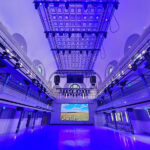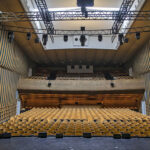Shakespeare & Company was running out of space. The theatre company, founded in 1978 with a mission of combining the strengths of classical British and American acting, first secured residency in the turn-of-the-century estate that was home to writer Edith Wharton, then in 2000 expanded to 30 acres with multiple buildings one mile away in Lenox, Mass. Even after moving to the larger location in 2001, however, Shakespeare & Company found it needed additional rehearsal and performance space for its Elizabethan productions, more room for workshops, youth programs, seminars and retreats, and more space for its prop shops and costume storage.
With an annual budget stretched by a variety of ambitious programs and projects, Shakespeare & Co. opted to convert a 40-year-old hockey rink and field house already on the property. The challenge was to convert that building into usable space, while taking building codes, costs and even environmental concerns into consideration.
After several of years of planning, $7.5 million, and six months of active construction, from December 2007 to June 2008, the building has become home to the custom-designed Production and Performing Arts (PaPA) Center, including the new Elayne P. Bernstein Theatre.
“New construction is so much easier because you start with a flat piece of ground,” says Nicholas J. Puma, Shakespeare & Company’s managing director, CFO and project manager of PaPA. “There’s nothing in your way.”
At 70,000-square-feet, the building was oversized, understructured, and older than many current building codes. Seismic resistance requirements were met by reinforcing masonry walls. The building was also subdivided by a fire wall to help bring the structure up to code.
“When you renovate an existing building, you almost hear it saying to you, ‘Wait ‘til you see what I got over here!’” Puma laughs, explaining that the project required a design-build approach. “When you get into what’s behind a certain wall, or underneath a certain floor, or up in a rafter, you then find you can’t do what you’d originally wanted to do on paper.”
The finished project, says architect Stephan Green of Clark & Green, Inc., “essentially brought everybody — all the components of Shakespeare & Company — under one roof: the artistic staff, the technical staff and the public.”
The scene shop, finish shop and production shops sit next to rehearsal studios, theatre offices and experimental theatre space. Circulation patterns within the renovated building force people from different departments to collide. It’s something that hasn’t been tried before.
“The people from the performing arts can get together and discuss things with the people in the scene shop, and that’s not usual,” Puma says. “It was important to not only have everyone under one roof, but to design the interior so they came together.”
The lighting system was designed by Jeff Harris, lighting director for the New York City Opera, and was provided by theatrical supply company High Output, Inc. Harris says the biggest challenge presented by the PaPA Center was budgetary.
“They have a lot of space, but not a great deal of money,” Harris says, noting that the new space has been designed for expansion as Shakespeare & Company continues to evolve. “It was a challenge to make it versatile and as complete a theatre as possible. We had to make it workable and interesting without spending a fortune.”
One of the goals for the Bernstein Theatre was to achieve a performance space that is at once flexible and intimate. In comparison to Shakespeare & Company’s Founders Theatre with 425 seats, the Bernstein Theatre can vary from 156 to 180 seats in three different configurations.
“We wanted something that was both large enough to put at least 150 people, but intimate where we can do these new productions that we’re doing,” says Puma. “You need a more intimate setting than when you do King John, this huge Shakespearian play that has 100,000 people in it and fireworks and smoke, and you need to hand out Hazmat suits before the people sit down,” Puma says, of an early play in the Bard’s oeuvre which Shakespeare & Company tackled in 2005.
But an intimate space brings its own challenges when it comes to technical design — in this case, how to work around the new theatre’s lower ceiling height.
“We spent a lot of time trying to get the grid as high as we could above the floor,” Harris explains. “We needed to make sure there’s plenty of grid to light the stage, wherever it ends up.”
The theatre ceiling was already constructed of open-web steel joists, from which the pipe grid has been dead-hung. The theatre grid covers the entire space, not just the stage area, maximizing flexibility. No matter what configuration the theatre might take for a given production, the lighting is there to cover it.
“In the theatre, we have a special lighting grid that’s all in one plane,” says Green. “We don’t have a cross-grid, so it’s a very low-profile grid. The grid itself becomes the ceiling of the theatre.”
The rehearsal studios have a more conventional cross-grid.
“They have portable dimmers in those rooms,” Green says. “They will just use those rooms for rehearsals and temporary lighting to stage things.”
Budgetary restrictions meant Shakespeare & Company found they couldn’t afford the original lighting design for the new space, so the design was altered to accommodate not only immediate needs but also future expansion.
“The challenge was trying to keep those spaces viable for the future so lights could be added as money came in,” Harris explains. “We wanted to make it friendly for future development.”
Harris added grids for future expansion, left room for running additional cable and places for additional dimmers to plug into — as more funds become available, and as the future needs of the theatre will dictate.
“We put in the number of circuits that I thought was appropriate,” Harris says. “But they couldn’t afford that many dimmers.”
Harris chose ETC, praising their products’ reliability as well as the company’s service and support. He says he appreciates the attention ETC gives to “the little guy.”
“You don’t have to be huge for them to care about you,” Harris says. “It’s also a fabulous product — it’s very even, very forgiving.”
Because of cost concerns, the lighting kit is not extensive, with equipment limited to a minimum of what the space requires.
There are four ETCNet2 ports located within the theatre — one in the control booth and three on the walls of the theatre. The equipment in the new space includes three ETC Sensor+ dimmer racks, 94 D20E dimmer modules, one R20AF relay module, one CC20 constant circuit module, 48 AFM air flow modules and 47 six-circuit outlet boxes.
Energy efficiency was a component of the design, but practicality won out.
“Unfortunately, the fluorescents don’t dim so nicely through theatrical dimmers, so we ended up with incandescents,” Harris says. “The highest priority was to make it a workable and usable space and theatre, and those standards made it not so energy efficient.”
There had been discussion about using LEDs as aisle lights, with a nod toward environmental concerns, but the available technology wasn’t dimmable.
“We’re on the cusp of it,” Harris says. “Also, LED technology is still pretty expensive.”
With this backbone in place, and with room for future development, Harris says additional systems can be rented and temporarily installed as needed, with an eye toward permanent lighting installs when additional funding is available.
Lighting control is through an ETC Ion and is completely Ethernet-based. An ETC Unison is being used to control the architectural system with preset stations so the room can be configured easily.
“There are presets by each door,” Harris says. “You don’t have to be a lighting tech to get the look in the room you want. You can have a party in there without having to call in an electrician.”
The impact of the Bernstein Theatre’s intimate design is nothing short of “intense,” according to April Carmack, stage manager for The Goatwoman of Corvis County, which ran Aug. 1-31 in the new theatre.
“The furthest the audience gets from the stage at any point is probably about 20 feet here in the Bernstein,” Carmack says. “They are very, very close.”
The play features several flashback scenes, requiring quick changes in the lighting. Carmack, who had never run a lighting board before, says the process is a snap.
“Basically there’s nothing I can do wrong to it,” she laughs.
The play even features “live food” being cooked on stage, making the audience part of the action.
“They get to smell the coffee, and they smell the bacon, which really puts them into the space and into the reality of the show” she says.
Carmack likes the closeness offered by the Bernstein and thinks it’s key to the show’s success.
“There are quite a few things that are just right in the audience’s face,” she says. “It’s just so intense and it really gives them something to walk away with at the end of the night.”
The rest of the new PaPA center relies on natural light as part of its sustainable design, and to reduce costs.
“We’ve opened up the walls of the existing building,” Green says. “The theatrical studios have natural light, and the scene shop has translucent panels that bring in natural light. That not only lowers electrical bills, but it improves the health and welfare of the people working in those spaces.”
Green says the first order of business at the beginning of the renovation was to organize the grading around the site to both protect and organize the wetlands, and to preserve it for future development. This involved creating a new, 4,000-square-foot wetland garden and cleaning up and reseeding an existing 8,000-square-foot area with native species.
“We’re using the wetland garden as an enhancement to the entry experience,” says Green. “People get out of their car and they walk down along a wetland garden to the front entry of the building.”
Though the formal grand opening for the PaPA Center won’t take place until the 2009-2010 season, the new facility is already making waves. The new theatre allows for a longer season — and an expanded training program, costume rental business, and education department — which means increased revenue for Shakespeare & Company.
“It’s really been my privilege,” Puma says of being involved in the development and renovation of the new center. “It’s really sensational. We’re going to make history here. There’s nothing like this.”


